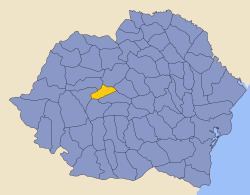Area 1,646 km² | ||
 | ||
Târnava-Mică County was a county (Romanian: județ) in the Kingdom of Romania, the successor to Kis-Küküllő County of the Austro-Hungarian Empire. Its capital was Diciosânmartin (now Târnăveni, in Mureș County).
Contents
Geography
Târnava-Mică County covered 1,646 km2 and was located in central part of Greater Romania, in Transylvania. Currently, the territory that comprised the greater part of Târnava-Mică County is now part of Sibiu County, Mureș County, and Alba County. In the interwar period, its borders were as follows: Turda County to the northwest, Mureș County to the northeast, Alba County to the west, Sibiu County and Târnava-Mare County to the south, and Odorhei County to the east. The counties were abolished in the administrative reform of September 6, 1950.
Administrative organization
Administratively, Târnava-Mică County was made up of three cities – Diciosânmartin, Ibașfalău (Elisabetopol, Elisabethstadt, Erzsébetváros), and Blaj – and was divided into four parts (plăși, singular plasă): I. Plasa Blaj, II. Plasa Diciosânmartin, III. Plasa Dumbrăveni, and IV. Plasa Iernut.
Population
Whilst still part of Austria-Hungary, in 1870, the population of Târnava-Mică County was 100,161. In 1891, the population of the county was 101,045, of which 49.1% were ethnic Romanians, 27.4% Hungarians, and 18.1% Germans.
According to the Romanian census of 1930 the population of Târnava-Mică County was 149,482, of which 53.9% were ethnic Romanians, 23.6% ethnic Hungarians, 16.1% Germans, 5.1% Romani, and 1.1% Jews. Classified by religion: 40.7% were Greek-Catholic, 16.6% Orthodox Christian, 16.6% were Reformed (Calivinist), 16.2% Lutheran, 4.6% were Roman Catholic, 3.3% Unitarian, and 1.1% Jewish.
Urbanization
In 1930 the urban population of Târnava-Mică County included 45.6% Romanians, 37.3% Hungarians, 5.6% Jews, and 5.3% Germans by ethnicity. The religious mix of the urban population was 38.0% Greek-Catholic, 18.8% Reformed, 12.9% Roman Catholic, 11.0% Eastern Orthodox, 6.2% Unitarian, 6.0% Jewish, and 4.7% Lutheran, and 1.2% Adventist.
